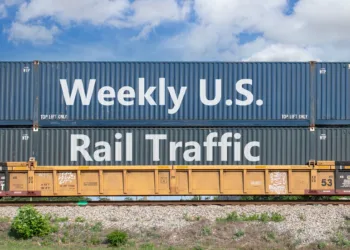Canadian National this week publicly expressed its support for the $85-billion acquisition agreement between Union Pacific and Norfolk Southern, a corporate marriage that if approved would create the first U.S. transcontinental freight railroad.
“CN is closely monitoring the ongoing discussions about possible transcontinental rail mergers,” the Montreal-based company (NYSE: CNI) said in a statement to FreightWaves. “Our focus remains on delivering consistent performance for our customers, pursuing strategic growth opportunities, and creating long-term value for our shareholders.
“CN believes this can be achieved through greater collaboration between railways, connecting key markets with critical resources.”
CN’s statement is notable in that the other Canadian transcon, CPKC (NYSE: CP), as well as BNSF and CSX (NASDAQ: CSX) in the U.S., declined to comment.
CN is an interchange partner with both UP (NYSE: UNP) and NS (NYSE: NSC), and is a partner in the UP-run EMP container program. CN also participates in UP’s Falcon Premium intermodal service with GMXT connecting Mexico, the U.S., and Canada.
But not everyone was as pleased with the announcement Tuesday that would create an integrated network stretching from New Jersey to Southern California.
“American Chemistry Council (ACC) and its member companies have serious concerns about the negative impacts on American manufacturing from further consolidation in the freight rail industry,” the trade group said in a statement. “We are closely watching the proposed terms of the deal and will actively oppose any merger that fails to significantly enhance competition between railroads.
“Our industry is one of the largest users of the U.S. freight rail system, and we need efficient and reliable service to deliver products that make people’s lives better, healthier, and safer.
“The four largest freight railroads already control more than 90% of U.S. rail traffic, with two dominating in the eastern U.S. and two dominating in the west. The impact of a transcontinental merger between two of these railroads threatens to leave American manufacturers, farmers and energy producers with even fewer competitive options to ship by rail.
“Many rail customers are currently dealing with high rates and unreliable service. Further consolidation within the rail industry is likely to make these problems worse.
“Producing and moving more chemistry here at home is key to growing the economy. From microchips to cars to medicines, if we want to make more things in America and lead in global trade, we must do a better job transporting American made goods. We call on policymakers to help create more competitive and reliable transportation options, not less.”
U.S. Sens. Roger Marshall (R-Kan.) and Tammy Baldwin (D-Wis.) in a letter urged the Surface Transportation Board to “keep the best interests of rail shippers and consumers in mind” during the board’s upcoming review of the merger, expressing concerns about the merger’s impact in a letter to board members.
Meanwhile, Nebraska Republican senators Deb Fischer and Pete Ricketts issued statements supporting the merger because of its economic impacts on their state.
Senior Bond Analyst Jay Cushing of researcher Gimme Credit said that the deal would produce combined revenue of $36.5 billion, operating earnings (EBITDA) of close to $18 billion, an operating ratio of 61%, and free cash flow of $2.6 billion.
“We estimate pro forma gross debt of $70 billion and net debt/EBITDA of 3.8x,” Cushing said in an email to FreightWaves. “This is about a turn above current last 12 months net leverage at Union Pacific (2.6x). Management is targeting $2.75 billion of run rate synergies over three years split between revenues ($1.75 billion) and costs ($1 billion). The synergy target amounts to 7.5% of combined revenue and looks reasonable when compared to a 9% target for the recent Canadian Pacific/Kansas City Southern merger.”
Cushing noted that Norfolk Southern was late implementing precision railroading “and we see room for operating rate compression between the industry laggard (NS) and leader (UP). Management expects combined free cash flow (before dividends) to grow from $7 billion in 2024 to $12 billion by 2029 driven by synergies and 10% base-line growth.
“Both companies will suspend share repurchases and with no funding plans until the deal closes, we expect cash to build on the balance sheet ($2 to $3 billion annually) helping moderate debt issuance needs. We view management’s net leverage target of 2.8x by 2028 as achievable.”
— with reporting by Trains magazine
Subscribe to FreightWaves’ Rail e-newsletter and get the latest insights on rail freight right in your inbox.
Find more articles by Stuart Chirls here.
Related coverage:
CEOs say Union Pacific-Norfolk Southern merger will reverse rail freight decline
Shippers line up against railroad mergers
Union Pacific and Norfolk Southern reach $85 billion merger deal
First look: Norfolk Southern earnings
The post While shippers cite concerns, rival railroad sees ‘value’ in mega-merger appeared first on FreightWaves.



















